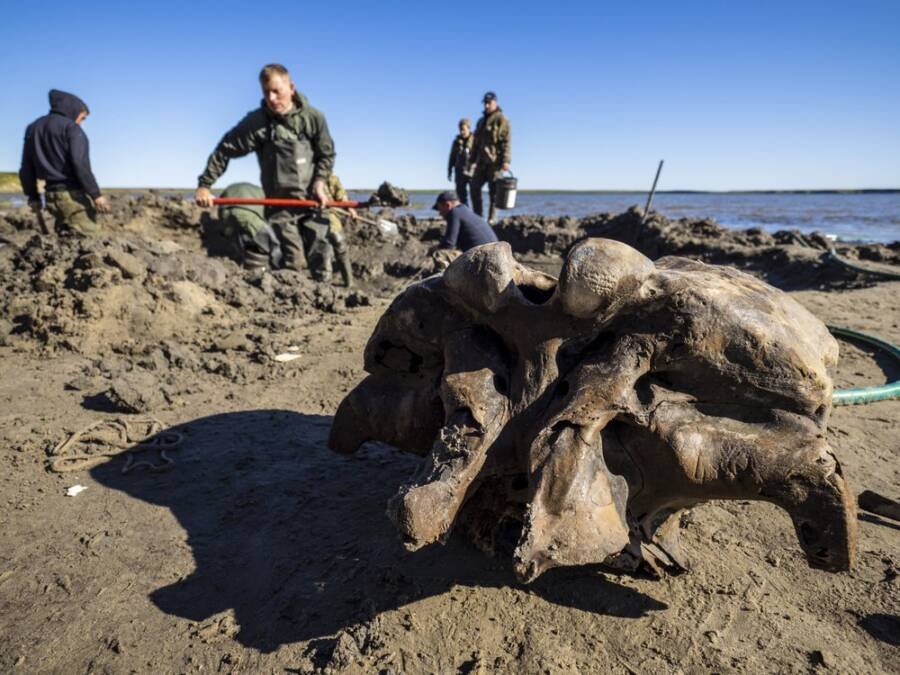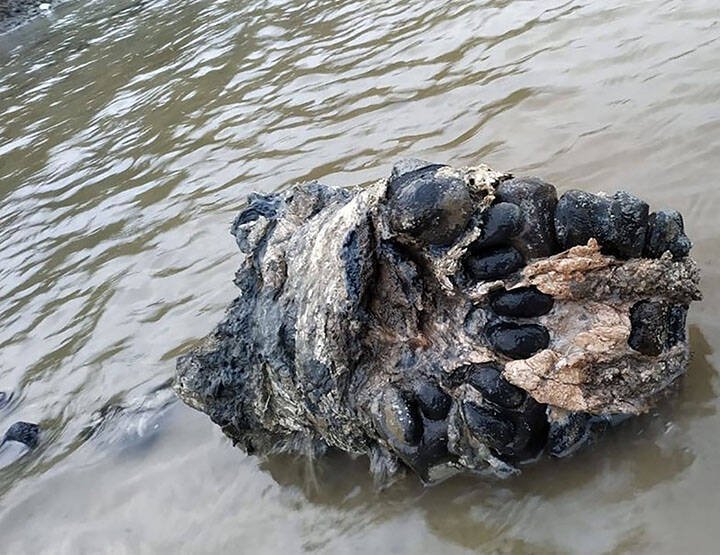Russian scientists are working to retrieve the well-preserved skeleton of the woolly mammoth.

The Siberian landscape is widely known for its rich resource for prehistoric fossils and a few days ago a group of local reindeer shepherds made a stunning discovery; they found a well-preserved skeleton of a woolly mammoth with its Ligaments intact.
The remains are so intact, that it still had some ligaments attached to it. The remains included part of the animal’s skull, lower jaw, several ribs, and a foot fragment with sinews still intact.
According to the Associated Press, a group of local reindeer herders stumbled upon the specimen in the shallow end of Pechevalavato Lake on June 20, 2020. Woolly Mammoths are thought to have died around 10,000 years ago, although scientists think that a small group of them lived longer in Alaska and on Russia’s Wrangel Island off the Siberian coast.
The locals quickly informed the researchers who have been working together with the locals to dig out the rest of the remains that are likely underwater, this will take a considerable amount of time to complete.

However, researchers are excited to see what’s under, as Dmitry Frolov, director of Arctic Research Center told The Siberian Times, “The whole skeleton is there.” Dmitry added that judging by the size of the fossils, this mammoth was likely young, but only further analysis will reveal how old it really was.
Woolly mammoths roamed our planet during the Pleistocene era until it’s extinction in the early Holocene epoch. The Pleistocene era lasted somewhere between 2,580,000 to 11,700 years ago. The mammoth was identified as an extinct species of elephant by Georges Cuvier in 1796.
They were roughly the same size as modern African elephants. Males reached shoulder heights between 2.7 and 3.4 meters (8.9 and 11.2 ft) and weighed up to 6 metric tons (6.6 short tons). Females reached 2.6–2.9 m (8.5–9.5 ft) in shoulder heights and weighed up to 4 metric tons (4.4 short tons). A newborn calf weighed about 90 kg (200 lb).
The woolly mammoth was well adapted to the cold environment during the last ice age. It was covered in fur, with an outer covering of long guard hairs and a shorter undercoat. The color of their coat varied from dark to light. Their long curved tusks and molars were replaced six times during the lifetime of an individual.

They co-existed with early humans, who used its bones and tusks for making art, tools, and dwellings, and the species was also hunted for food. It disappeared from its mainland range at the end of the Pleistocene 10,000 years ago. Isolated populations survived on St. Paul Island until 5,600 years ago and on Wrangel Island until 4,000 years ago.
“Finding a complete skeleton of a mammoth is quite rare”, said Yevegenia Khozyainova, a researcher from the Shemanovsky Institute in Salekhard. However, several other well-preserved remains have been found in the permafrost of Northern Siberia recently as a heatwave which has been ripping through the territory over the summer melts the thick ice.
Another discovery was made in May 2020, the remains of 60 individual mammoths were retrieved from construction right outside of Mexico City, Mexico.
Experts suspect that the mammoths in in Mexico died in the ancient lake after they became trapped in the surrounding mud and it was possible that human hunters capitalized on their misfortune. It took almost six months for a team of researchers to dig out the remains and work on the site continues today.

The frozen tundra of the Siberian permafrost has been famously known to produce unbelievable well-preserved specimens. In 2011 scientists were able to analyze the DNA of 28,000-year-old woolly mammoth that was incredibly well-preserved in permafrost.
“Until now many studies have focused on analyzing fossil DNA and not whether they still function, This suggests that, despite the years that have passed, cell activity can still happen and parts of it can be recreated,” said study author Kei Miyamoto from the Department of Genetic Engineering at Kindai University.
Study in 2011 has led to highly publicized discussions about possible cloning the woolly mammoth back to life from these active DNA strains.










